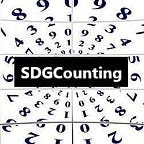SDG 2 Indicators- 2017 Updates
The updated list of SDG #2 Indicators since July 2016, with changes highlighted.
In summer 2016, we created a series of Medium stories listing the targets and indicators for the Sustainable Development Goals. Since then, meetings have been held that have altered and edited the global indicators framework. Here, we highlight the changes and additions that have been made since July 2016 up to April 2017, to update our indicator stories before the High Level Political Forum takes place in July 2017.
*Changes and additions to indicators are italicized, along with notes from the IAEG-SDGs as to the purpose of the edit. Changes begin at Target 2.b.
SDG 2: No Hunger — Indicators by Target
Target 2.1. By 2030, end hunger and ensure access by all people, in particular the poor and people in vulnerable situations, including infants, to safe, nutritious and sufficient food all year round
Indicator 2.1.1: Prevalence of undernourishment
Indicator 2.1.2: Prevalence of moderate or severe food insecurity in the population, based on the Food Insecurity Experience Scale (FIES)
Target 2.2. By 2030, end all forms of malnutrition, including achieving, by 2025, the internationally agreed targets on stunting and wasting in children under 5 years of age, and address the nutritional needs of adolescent girls, pregnant and lactating women and older persons
Indicator 2.2.1: Prevalence of stunting (height for age <-2 standard deviation from the median of the World Health Organization (WHO) Child Growth Standards) among children under 5 years of age
Indicator 2.2.2: Prevalence of malnutrition (weight for height >+2 or <-2 standard deviation from the median of the WHO Child Growth Standards) among children under 5 years of age, by type (wasting and overweight)
Target 2.3. By 2030, double the agricultural productivity and incomes of small-scale food producers, in particular women, indigenous peoples, family farmers, pastoralists and fishers, including through secure and equal access to land, other productive resources and inputs, knowledge, financial services, markets and opportunities for value addition and non-farm employment
Indicator 2.3.1: Volume of production per labor unit by classes of farming/pastoral/ forestry enterprise size
Indicator 2.3.2: Average income of small-scale food producers, by sex and indigenous status
Target 2.4. By 2030, ensure sustainable food production systems and implement resilient agricultural practices that increase productivity and production, that help maintain ecosystems, that strengthen capacity for adaptation to climate change, extreme weather, drought, flooding and other disasters and that progressively improve land and soil quality
Indicator 2.4.1: Proportion of agricultural area under productive and sustainable agriculture
Target 2.5. By 2020, maintain the genetic diversity of seeds, cultivated plants and farmed and domesticated animals and their related wild species, including through soundly managed and diversified seed and plant banks at the national, regional and international levels, and promote access to and fair and equitable sharing of benefits arising from the utilization of genetic resources and associated traditional knowledge, as internationally agreed
Indicator 2.5.1: Number of plant and animal genetic resources for food and agriculture secured in either medium or long-term conservation facilities
Indicator 2.5.2: Proportion of local breeds classified as being at risk, not-at-risk or at unknown level of risk of extinction
Target 2.a. Increase investment, including through enhanced international cooperation, in rural infrastructure, agricultural research and extension services, technology development and plant and livestock gene banks in order to enhance agricultural productive capacity in developing countries, in particular least developed countries
Indicator 2.a.1: The agriculture orientation index for government expenditures
Indicator 2.a.2: Total official flows (official development assistance plus other official flows) to the agriculture sector
Target 2.b. Correct and prevent trade restrictions and distortions in world agricultural markets, including through the parallel elimination of all forms of agricultural export subsidies and all export measures with equivalent effect, in accordance with the mandate of the Doha Development Round
Indicator 2.b.1: Agricultural export subsidies
Previous Indicator: Producer Support Estimate [The Percentage Producer Support Estimate (%PSE) represents policy transfers to agricultural producers, measured at the farm gate and expressed as a share of gross farm receipts. Transfers included in the PSE are composed of market price support, budgetary payments and the cost of revenue foregone by the government and other economic agents.]
UNSC 48 refinement: Formerly 2.b.2. Removed original 2.b.1.
2.c. Adopt measures to ensure the proper functioning of food commodity markets and their derivatives and facilitate timely access to market information, including on food reserves, in order to help limit extreme food price volatility
Indicator 2.c.1: Indicator of food price anomalies
Moved from Tier 3 to Tier 2, Fast Track; Reviewed at 5th IAEG-SDG meeting
